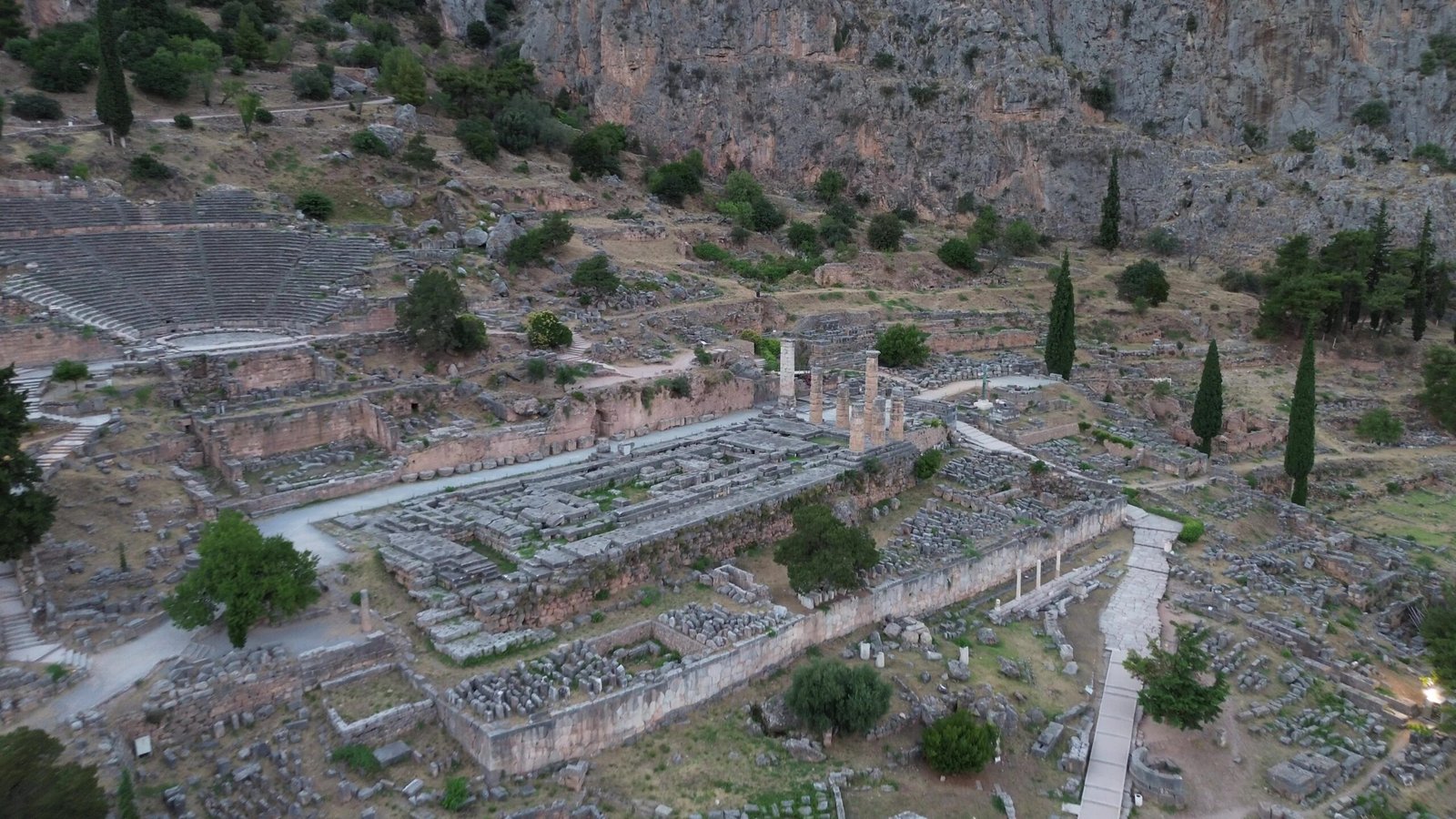Delphi is one of the most significant and revered archaeological sites in Greece, known for its rich history, cultural significance, and association with ancient Greek religion. Located on the slopes of Mount Parnassus, Delphi was once considered the center of the world in Greek mythology and housed the famous Oracle of Delphi, where the priestess Pythia provided cryptic prophecies.
Key Features of Delphi:
- The Temple of Apollo:
- The most important structure at Delphi, dedicated to the god Apollo, who was believed to communicate through the Oracle. The temple, built in the 4th century BCE, was the third version of the temple on the site. It was here that the Oracle sat, delivering prophecies to those seeking guidance.
- The temple was adorned with inscriptions and artwork, and within it was the adyton, the inner chamber where the Pythia gave her prophecies.
- The Oracle of Delphi:
- The Oracle was one of the most famous institutions of ancient Greece, where the Pythia, a priestess of Apollo, would enter a trance-like state and deliver prophecies.
- People from all over the ancient world, including leaders like Alexander the Great, visited Delphi to seek advice from the Oracle.
- The Theatre of Delphi:
- Located above the Temple of Apollo, this ancient Greek theater could seat around 5,000 spectators. It hosted performances of music, drama, and poetry during the Pythian Games and other festivals dedicated to Apollo.
- The theater is known for its spectacular views of the valley and the sanctuary below.
- The Stadium:
- The stadium at Delphi, located even higher than the theatre, hosted the athletic contests of the Pythian Games, a major festival held every four years. The games included athletic, musical, and poetic competitions in honor of Apollo.
- It could hold around 6,500 spectators and had a running track measuring about 177 meters.
- The Tholos of Delphi:
- The Tholos is a circular building located in the sanctuary of Athena Pronaia, separate from the main Temple of Apollo. Built around 380 BCE, its purpose is still debated, though it is believed to have had religious significance.
- The structure is famous for its elegant design and columns, and its ruins are one of the most photographed parts of Delphi.
- The Sacred Way:
- This was the main road through the sanctuary of Apollo, leading from the entrance to the Temple of Apollo. Along this path were treasuries, monuments, and statues donated by city-states, showing the wealth and reverence of those who visited Delphi.
- The Treasuries:
- Various Greek city-states built treasuries along the Sacred Way to house their offerings to Apollo. The most famous is the Treasury of the Athenians, a beautiful building that stored gifts and tributes.
- These treasuries reflected the prestige of the city-states and their devotion to the god.
- The Pythian Games:
- Held every four years, the Pythian Games were one of the four Panhellenic Games of ancient Greece, second only to the Olympic Games. They were held in honor of Apollo and included athletic events, chariot races, and artistic competitions in music, poetry, and drama.
Historical and Cultural Significance:
- Religious Center: Delphi was the most important religious sanctuary in ancient Greece, considered the “navel of the world” (omphalos). Legend has it that Zeus released two eagles, and they met at Delphi, marking it as the center of the world.
- Panhellenic Influence: The sanctuary united the Greek world, as city-states, leaders, and individuals visited to seek guidance from the Oracle. It was a center for diplomacy, religious ceremonies, and athletic competitions.
- Political Importance: Delphi played a crucial role in Greek politics. Many leaders consulted the Oracle before making significant decisions, especially in matters of war and colonization. The Oracle’s responses, although cryptic, were taken seriously.
- Archaeological Findings: Excavations at Delphi have uncovered numerous artifacts, including statues, inscriptions, and everyday items. Many of these are now housed in the Delphi Archaeological Museum, which contains masterpieces like the Charioteer of Delphi, a bronze statue from around 470 BCE.
Mythological Context:
Delphi was deeply tied to Greek mythology. According to legend, Apollo slew the Python, a serpent that guarded the site, and then established his sanctuary there. The Omphalos stone, believed to be the center of the world, was kept at Delphi as a symbol of this myth.
UNESCO World Heritage Site:
Today, Delphi is a UNESCO World Heritage Site, recognized for its historical, cultural, and architectural significance. It attracts visitors from around the world who come to explore its ruins, learn about ancient Greek religion, and enjoy the breathtaking views of the surrounding mountains and valleys.
Delphi stands as a powerful reminder of the ancient Greeks’ religious beliefs, artistic achievements, and their quest for knowledge and guidance from the divine.



